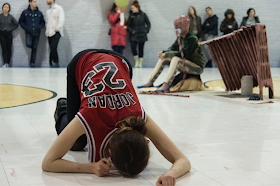by Josh Dihle
Editor: Sofia Leiby
Works by Anastasia Douka, Michaela Murphy, and Ilie Paun Capriel
Installation view of The Four Horsemen
The painted demarcations of the gym floor indicate the intended areas for sport, zones where bodies are marshaled and put through selected exercises. The printed felt banners hanging high on the walls proclaim years of victory in italics. The middle school gymnasium, like the sanctuary of a church, is a place of ritual and rite found in every community in America. Notably, the props, sets, and videos from Mike Kelley’s performative cycle "Day is Done" have seasoned these sites as rich territories for exploring a nuanced visual language while illuminating the cultish weirdness of the celebrations, games, and rites-of-passage which are often taken for granted. The Four Horsemen landed on this turf and forged ahead with new inquiries and condemnations.
Ilie Paun Capriel, Untitled, 2014
Ilie Paun Capriel hung painted monochromes across the gym’s basketball backboards, removing some of the hoops and leaving them on the floor below. Extended and stuffed with colorful inflated bladders, the basketball nets resembled strange, pendulous bellies. In prim dialogue with the solid colors and geometries of the building, Paun Capriel’s works blurred the division between utilitarian forms and purely aesthetic ones. A particularly rich confluence occurred behind one basketball hoop, where the school had installed a puffy gray mat on the wall to protect the bodies of students during a post-layup collision. Paun Capriel’s authorship commandeered it as a readymade Minimalist painting and slyly relieved it of its kindly purpose.
Anastasia Douka, Untitled, 2014
By contrast, Douka’s work resisted the gym’s rigidity with wonkiness: draped netting, intimate dangling enclosures, unraveled scroll forms, and pliant casts of lamp posts sprawled with indulgent inattention to the gym’s severe backdrop. A minor off-note was struck by a stationary masked figure seated among the sculptures, which invited a somewhat banal stage-set reading of the scene that drew attention from Douka’s otherwise fascinating scramble of sculptures and hangings.
Michaela Murphy, It Takes a Little More to Make a Champion, 2014
The stakes in the overlapping spheres of sport, religion, education, and art are perhaps best defined by group-held belief. Michaela Murphy adroitly punctured each of these spheres in her deceivingly simple performance, It Takes a Little More to Make a Champion, in which she donned a Michael Jordan jersey while crawling, licking, and spitting on the gym’s floor. The reddish smudges interspersed with shoe marks on the gym’s floor revealed themselves to be the artist’s blood, as spat out every few seconds throughout the show. Murphy’s willful obedience to a painful and absurd agenda cast fiery aspersions on the daily routines taking place in the gym. And yet, there was a generosity in her actions, not in the martyr/savior sense, but through a subtler negotiation. By pushing away all logic save that of the physical act itself, Murphy opened a chasm in the gym, collapsing the rituals of penance and practice into a single astounding gesture of control and subjugation. This work, and the others in The Four Horsemen, stood out as a short-lived but tenacious display that cut an ambitious swath through the blind belief in a cause often shared by sporting, religious, and aesthetic adherents.
The Four Horsemen took place February 16, 2014, from 6–8pm at the St. Sylvester School Gymnasium, 3027 W. Palmer Square, Chicago, IL. All images courtesy Yunyu Shih and Dana DeGiulio.





No comments:
Post a Comment